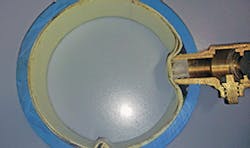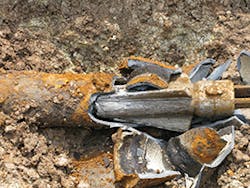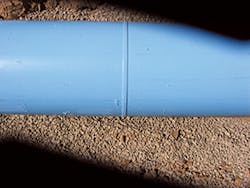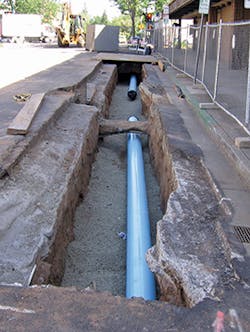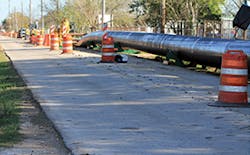Trenchless technologies, developed over the past 30 years, have become the first choice for many water agencies to greatly reduce the cost of replacing corroded and deteriorating water and sewer lines and, instead, reline or rehabilitate them.
According to Todd Grafenauer, Education Director with Murphy Pipeline Contractors headquartered in Jacksonville, FL, trenchless technologies date from the 1970s in the United Kingdom when British Gas discovered the majority of its pipelines were reaching the end of their lifetimes, just as water, wastewater, and sewer lines in the United States are today.
Cutting trenches open to replace pipelines (called “open cut”) can be astronomically expensive, so British Gas looked for more efficient and less expensive ways to replace their pipes. Thus, trenchless technologies were developed in Europe and many found their way to the US.
There are several types of trenchless technologies that all require digging pits at the front end and back end of the pipe to be lined and repaired. Liners or new pipe are pulled through the host pipe from the front pit to the end pit. The types of technologies available include pipe bursting, pipe splitting, swagelining, sliplining, or cured-in-place to pull through high-density polyethelyne (HDPE) or polyvinyl chloride (PVC) replacement pipes.
Using swagelining technology, HDPE pipe is pulled through a “reduction die” which reduces its diameter, allowing it to be inserted into and pulled through the smaller host pipe.
Choosing a technology for a given project depends on several variables. The size of pipe being rehabilitated will dictate either HDPE or PVC. Whether the pipe diameter can be shrunk or maintained to provide adequate water supplies is a crucial decision-making point.
There are other costs as well to consider, says Grafenauer. Communities may not want to shut down roads affecting local businesses and homeowners if trenches are cut open. Carbon output is 90% less with trenchless technology, because less equipment is used and less diesel burned, cutting back on emissions. Furthermore, design costs would increase with open cut work. With many trenchless methods, the existing utility path is followed, he says.
Three Cities Join in CIPP Project
Cured-in-place Pipe (CIPP) was invented by Insituform Technologies, an Aegion company in 1971, as a solution to rehabilitating underground pipelines without digging. Before the liner is inserted in the pit, an epoxy is poured into the liner and pressed into it. A bladder is then inserted and taped. Once the liner is pulled into place, it is inflated to 18 pounds of pressure and held for four hours. The bladder is pulled out, and the new cured-in-place pipe is left in place.
Then robotic cutting devices are sent down the new pipe to restore water flow to the service pipes. If robots are not used, a pavement cut at every single-service pipe would have to be made.
The City of Golden Valley, MN, needed to replace or repair a portion of its cast iron water main, and in 2010 embarked on a cooperative project agreement with two other nearby cities to use a new technology that could potentially save them money. The cities of nearby Fidley and Hutchinson also had corroded water main lines that needed rehabilitation.
As Mitch Hoeft, a utility engineer with Golden Valley’s public works department, explains, the three cities wanted to try cured-in-place pipe technology. Engineers from the three cities, which are suburbs of Minneapolis and St. Paul, knew each other through industry organizations. Together, they hired the consulting firm Short Elliott Hendrickson Inc. (SEH) to draw up the documents required for a cooperative project agreement, similar to a joint powers agreement.
The cooperative project agreement increased the size of the product quantities and combined transportation costs into one bid document to attract out-of-state contractors. A contract issued by just one of the three cities wouldn’t be large enough to tempt contractors, according to Hoeft.
As SEH project manager Paul Pasko III described in the August 2011 issue of Public Works Manual, he developed a series of documents and shepherded the agreement and bid documents through the three city councils. The bidding document included a questionnaire each bidder had to complete to prove they were competent to install CIPP technology and to use robots to reinstate water service pipes and complete restoration measures.
The city partners for the most part agreed in advance on design, construction, and testing methods. Accommodation was made for those who asked for different pavement restoration, turf establishment methods, and temporary water main networks, according to Pasko.
Static pipe bursting
Wherever possible, SEH tried to use the same bid-unit pay items across all three cities to balance the cost equally. For example, according to Pasko, “The 12-inch lining pay item combined the pipe length for all three cities.”
Two companies qualified: Insituform Technologies in Chesterfield, MO, and Fer-Pal Construction USA LLC in Taylor, MI. Fer-Pal’s low bid was selected to install Sanexen Environmental Services’ Aquapipe.
Combined, the projects represented one mile of work, but it was for three non-adjacent locations. Because of Minnesota’s below-freezing winter air temperatures, the construction seasons are short.
According to Hoeft, “Once temperatures drop, we can’t obtain our typical hot-mix asphalt to properly restore the four- to eight-foot pits in roadways through which the lining was inserted into the pipe.”
Hoeft says for that reason, the job was completed in two summer cycles: 1,500 linear feet were completed in 2010, and the remainder of the work was completed in 2011. He says the bid prices increased because the cities wanted the jobs to be completed quickly.
Hoeft reports the total cost to complete 5,500 linear feet was $1,174,755. That cost includes excavation, setup of temporary water line, lining, and full restoration. The cost was split by the three cities based on the total length of lined pipe installed in their territories.
Hoeft says a pit was dug every 500 feet in which the liner was inserted in the corroded cast iron pipe. Using the robots to restore service connections not only saved money, but minimized street disruption and soil compaction issues, according to Pasko, the SEH consultant.
There were a minimum number of surprises, Hoeft says. Gate valves at numerous large-diameter water services were too close to the trunk water main pipe and contractors had to replace them to prevent lining resin fouling.
Also, “We ran into one-36-inch concrete electrical duct that didn’t match the as-builts,” he says. The change order cost $4,000 but change orders affected less than 1% of total project cost, Hoeft says.
Hoeft recommended that liquidated damages be included in the contract: deduct a specified amount per day from the final payment to the contactor until the job is finished beyond the contracted finish date. He also recommended that the schedule and specifications be tightened to ensure the work is feasible for all partners.
Sliplining Produces an Easy Solution
Sliplining involves opening up the corroded host pipe after shutting off service valves, and cleaning it to remove tuberculation (minerals and scale) that has built up. The lengths of PVC pipe needed to fill the length of the host pipe are fused together with heat and then inserted. The following day both ends are capped and the annular space between the old pipe and the new pipe is filled with grout.
Fused PVC pipe
The line is then filled with potable water injected with high concentrations of chlorine for disinfection. The new line is pressurized to 150 psi and held for two hours to verify there is no detectable leakage. Once the new line passes the pressure test it is allowed to “sit” for 24 hours to allow the chlorine to disinfect the pipe. The chlorine is flushed with fresh potable water and allowed to remain for 24 hours. After being tested and confirmed that no coliform bacteria are present, the new pipe is connected to the existing line.
The Roseville, CA, water department embarked on a major project starting in 2010, to rehabilitate its 16-inch cast iron water main located under the city’s main street. The water main had been installed in the 1920s.
The pipe was corroded and deteriorating, according to Jose Lopez, senior engineer. The first phase involved 400 feet of water main that crossed under four railroad tracks at the junction of the largest switchyard in the western states, he says. The tracks led to and from the northern and eastern states.
Given the location, it would be catastrophic if the pipeline failed, Lopez says. The department chose to slipline a
Sliplined PVC pipe in pit
new fusable 12-inch PVC pipe inside the old 16-inch pipe. They considered cured-in-place, but they were not comfortable at the time with the relatively new technology.
HDPE pipe was a viable alternative, but its thickness would cut down capacity to 10 inches with the same outside diameter. Furthermore, the HDPE pipe didn’t conform to the typical pipe size–the outside diameter was different from the cast iron pipe. While the C900 PVC pipe can interchange fittings, HDPE pipe uses special fittings.
Lopez says just two pits were necessary–insertion and exit–to slipline the pipe. The simplicity of the job was an advantage. Construction was completed in less than 30 days. The project cost about $200,000, he says.
Roseville Also Chose CIPP
The next project the Roseville water department completed was divided into two phases with the first phase finished in 2012. The original steel transmission line stretching 3,330 feet dated from the 1920s. Again the department chose to slipline the pipe, using fusable PVC.
The street had been landscaped about ten years ago, including resurfacing and widening the roadway. The desire was to not disrupt that work. Furthermore, this section of the city is occupied by mom-and-pop stores and shops and sliplining would minimize or completely avoid disrupting those businesses.
Because of the size of the project and the curvature of the existing pipe, the work was performed in phases at different locations, Lopez says. The job required that three pits be dug (one at each end and one in the center) to allow work to proceed outward from the center of the project.
The second phase in 2013 involved rehabilitating 2,200 feet of pipe on the same line. It had five 90-degree bends. Each bend required an insertion pit at each end, meaning seven insertion pits had to be dug. Lopez says, “The street makes an S curve, and as the city grew, the streets took funny curves.” As a result, this phase cost $1.3 million.
The newest project is ongoing and is a continuation of the same street pipeline repairs. Bids were expected in July with start of construction expected in August. It involves 1,400 feet of 16-inch cast iron pipe. There was concern about a decrease in the diameter of new pipe, Lopez says. New and larger pipelines around the periphery of the area can serve the older area by backfeeding based on a water model analysis the staff ran, he says.
However, it was decided to go with cured-in-place technology for the first time. The reason, says Lopez, is it will decrease the inside diameter of the 16-inch existing pipe only one inch. Given that the pipeline is the major feeder for the older part of town and with concerns about water supply there, staff decided to not decrease pipe diameter any further than 15 inches. Sliplining would decrease pipe diameter to 12 inches. The cost of the project is budgeted at $450,000.
Cast Iron Line Buried Under Tracks
In downtown Little Rock, AR, a spontaneous water main break occurred at the most inopportune time adjacent to a railroad line. Jim Ferguson, director of engineering for Central Arkansas Water, says because of its proximity to railroad tracks, the pipe could not be dug up.
Demonstrating trenchless technology, a large HDPE replacement pipe is loaded into a pit and pulled through a corroded host pipe.
The utility is 120 years old, and its cast iron or ductile iron pipes are as much as 115 years old, with a history of breaking. The particular pipe with the leak was a 114-year-old, 12-inch cast iron pipe. The choice was to slipline 600 linear feet of fusable PVC pipe into the cast iron pipe.
The hydraulics were good enough that reducing the pipe diameter from 12 inches to 8 inches caused no problems, says Ferguson. The iron pipe had a buildup of minerals and scale adhering to its walls. Once the new PVC pipe was inserted, the coefficient of friction was improved.
In a new rehabilitation project in mid-town, Ferguson says the water department chose cured-in-place technology. The department did not feel comfortable using it on the project near the railroad track because the technology was new (at least to management) when the leak was discovered. However, it is now being installed around the country and Ferguson and his colleagues decided to use it. This is the first application in Arkansas, he says.
The 1,300 feet of 60-year-old 16-inch cast iron pipe which had been experiencing spontaneous main breaks was located in a part of the heavily developed downtown area. Ferguson says they used a reduced open-cut and partial trenchless procedure. The line was put back in service at the end of May, he says.
Central Arkansas Water has 2,500 miles of pipes, and the average age is 40 years. “We’re just like every other utility with pipes wearing out that need to be rehabilitated,” says Ferguson. “We budget for both rehabilitating in place and complete replacement, but we’re behind the curve and need to increase the budget” to do that work, he says.
In contrast to reports from other water agency managers, Ferguson says the costs for both sliplining and cured-in-place projects are at least double the costs of open cut replacement projects, but each job is different. The costs of these alternatives must be measured with the unexpensed social costs of open-cut jobs, which disrupt traffic and business in highly developed downtown areas in particular, he says.
Sonar Finds Water Main Leak
The Fairfax, VA, utility department two years ago discovered a weakened section in its 24-inch precast concrete potable water main that runs under its Dulles Toll Road. The line runs from its water treatment plant under 500 feet of lanes and next to pilings. It was laid fairly shallow and utility director Rick Thoesen (who retired just after this interview was conducted) says the line should have been relocated when the city built an access road dedicated to the airport and the toll road for other traffic.
The department considered cured-in-place technology and HDPE pipe, but chose PVC sliplining to save the alignment. The 24-inch pipe was reduced to 20 inches in diameter once the sliplined pipe was in place. The old pipe became the casing, Thoesen says.
The department rejected using HDPE because the thicker HDPE would have left 3 feet (or less) of frictional head losses. When going from larger pipe to smaller pipe, during maximum flow the less the head loss the better, Thoesen says. The sliplining resulted in smooth pipe, and pressure loss was minimal.
Cured-in-place technology was rejected to avoid liability. The line was horizontal, and if the bladder got jammed, “we would have never gotten it out,” says Thoesen. “We have used cured-in-place technology in gravity pipes, and it was the default replacement in the past.”
The weak section was discovered after using Pure Technologies sonar and acoustic feedback technology. Thoesen says it would have been disastrous if an actual leak had occurred and the department had to make a conscious effort to prevent opening up a leak.
Thoesen says the city replaces 1% of pipeline each year. “Ideally, you’d replace the entire pipeline every 50 years. Optimally, we’d like to replace it on a 75-year cycle, but we’re now on a 100-year cycle” because of limited revenues, he says.
Swagelining Cures PCC Lines
Swagelining was developed and trademarked by Swagelining Limited, a company that develops polymer lining technologies. The HDPE pipe that will be inserted using swagelining must have an outside diameter larger in size than the inside diameter of the host pipe to be relined. After HDPE pipes are fused to correspond to the pull distance the pipe is pulled through a type of box called a reduction die immediately before entering the host pipe. This reduces the HDPE pipe temporarily below the interior diameter of the host pipe, allowing it to be inserted.
The towing load keeps the HDPE under tension during the pull and it remains fully elastic throughout the installation process. Once the pull is completed, the pulling equipment is removed allowing the HDPE pipe to expand until it is halted by the inside diameter of the host pipe to create a tight fit. The final interior diameter maintains or increases flow. This lining method can install thin-walled HDPE lines through fully structural HDPE pipe, depending on the requirements for each project.
Murphy Pipeline Contractors completed a job in June for the Gulf Coast Water Authority that provides water to League City, TX, outside of Houston. A 39-inch pre-cast concrete (PCC) water transmission pipeline installed in the 1970s needed relining. Its steel wire wrapping was corroding and becoming brittle. Grafenauer, Murphy’s education director, says this is a massive problem for utilities that had installed precast concrete pipelines 40 years ago.
Gulf Coast looked at sliplining with both PVC and HDPE pipes and swagelining with HDPE. The water company designed projects using all three technologies and assigned point values to each attribute. It was important to maintain the 39-inch interior diameter, and it got the largest number of point values. The cost of the project received fewer points as its price increased.
Murphy Pipelines demonstrated the highest score and won the project, Grafenauer says. It used swagelining and fully structural HDPE (DR 17) to reline the existing PCC host pipe. The total project of 6,800 linear feet was completed with four different pulls, averaging 1,200 to 2,200 linear feet per pull. Grafenauer says each pull took less than one day. A temporary bypass was set up to continue delivering water during the project.
Grafenauer says excavation was reduced by 91% in comparison to an open cut technique to expose the pipeline.
Plymouth Selects Pipe Bursting
Static pipe bursting is used to burst fracturable host pipe such as cast iron, PVC, and asbestos cement pipe. Using a bursting head, this technology fractures a pipe from the inside and forces the fragments outwards while a new pipe is drawn in to replace the old one. Pipe splitting is used on ductile iron and steel, which cannot be burst. A ductile slitter with wheels splits the pipe and another tool opens it up, allowing the new pipe to be pulled through.
Plymouth, MN’s water system dates from the 1960s when it transitioned to a city from a township. Previous to that, water was supplied with individual wells. The city’s current supply is provided through municipal wells. The original pipes were cast iron, but when some started pitting, they were replaced with ductile iron pipes.
Dan Campbell, senior engineering technician for Plymouth’s water and sewer department, says the Public Works management has since set the standard at PVC.
When a cast iron water main running next to Lancaster Lane in Plymouth started leaking, the department chose pipe bursting and fused PVC to minimize the impact on the roadways and the other utilities underground, including telephone, gas, cable TV, and electrical lines.
Since 4,000 linear feet of PVC was to be pulled through the pipe as it was burst, the project had to be completed in three phases, with front and end pits dug for each phase for a total of six pits.
“We could only do a certain amount of pipe at one time so we wouldn’t be too far away from fire hydrants,” says Campbell. “We would do this type of project next time with less service line tie-ins required after the pipe was repaired.”
The additional pits increased the amount of disturbance digging them and increased project costs by $150,000 over the budgeted amount, says Campbell. The project ended up costing $1.15 million.
“We’ve been slowly rehabilitating existing pipes because they are deteriorating pretty fast,” says Campbell, adding, “The acidic soils are eating metal away and corroding bolts. The PVC pipe is impervious to that problem.”
